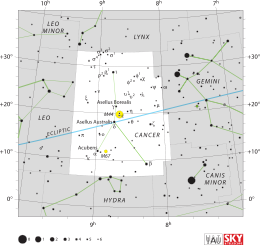Mu2 Cancri is a solitary,[10] yellow-hued star in the zodiac constellation of Cancer. It is visible to the naked eye with an apparent visual magnitude of +5.30.[2] Based upon an annual parallax shift of 42.36 mas as seen from Earth,[1] this star is located 77 light-years from the Sun. It is drifting closer with a radial velocity of −36 km/s[5] and will make its closest approach in about 611,100 years when it passes at a distance of 16.8 light-years (5.2 parsecs).[11]
| Observation data Epoch J2000.0 Equinox J2000.0 (ICRS) | |
|---|---|
| Constellation | Cancer |
| Right ascension | 08h 07m 45.85581s[1] |
| Declination | +21° 34′ 54.5325″[1] |
| Apparent magnitude (V) | +5.30[2] |
| Characteristics | |
| Evolutionary stage | Subgiant[3] |
| Spectral type | G2 IV[4] |
| U−B color index | +0.21[2] |
| B−V color index | +0.63[2] |
| Astrometry | |
| Radial velocity (Rv) | −36.0±0.1[5] km/s |
| Proper motion (μ) | RA: +23.610[1] mas/yr Dec.: −68.122[1] mas/yr |
| Parallax (π) | 42.3605 ± 0.1251 mas[1] |
| Distance | 77.0 ± 0.2 ly (23.61 ± 0.07 pc) |
| Absolute magnitude (MV) | +3.46[6] |
| Details | |
| Mass | 1.192+0.017 −0.016[7] M☉ |
| Radius | 1.82[8] R☉ |
| Luminosity | 3.782±0.015[1] L☉ |
| Surface gravity (log g) | 3.97±0.02[7] cgs |
| Temperature | 5,809±59[7] K |
| Metallicity [Fe/H] | 0.11[7] dex |
| Rotational velocity (v sin i) | 3.7±0.3[6] km/s |
| Age | 5.64+0.35 −0.14[7] Gyr |
| Other designations | |
| Database references | |
| SIMBAD | data |
At the estimated age of 5.6 billion years,[7] Mu2 Cancri is an evolving G-type subgiant star[3] with a stellar classification of G2 IV.[4] It has 1.2[7] times the mass of the Sun and 1.8[8] times the Sun's radius. Mu2 Cancri has relatively high metallicity—what astronomers term the abundance of elements other than hydrogen and helium—having a 29% higher abundance compared to the Sun.[7] It is radiating 3.78[1] times the Sun's luminosity at an effective temperature of 5,809 K.[7] The star is spinning at a leisurely projected rotational velocity of 3.7 km/s.[6]
References
edit- ^ a b c d e f g h Brown, A. G. A.; et al. (Gaia collaboration) (August 2018). "Gaia Data Release 2: Summary of the contents and survey properties". Astronomy & Astrophysics. 616. A1. arXiv:1804.09365. Bibcode:2018A&A...616A...1G. doi:10.1051/0004-6361/201833051. Gaia DR2 record for this source at VizieR.
- ^ a b c d Johnson, H. L.; et al. (1966), "UBVRIJKL photometry of the bright stars", Communications of the Lunar and Planetary Laboratory, 4 (99): 99, Bibcode:1966CoLPL...4...99J.
- ^ a b Abt, Helmut A. (May 2019), "The Evolutionary Status of GK Subgiants", The Astronomical Journal, 157 (5): 5, Bibcode:2019AJ....157..177A, doi:10.3847/1538-3881/ab11c6, 177.
- ^ a b Gray, R. O.; et al. (July 2006), "Contributions to the Nearby Stars (NStars) Project: Spectroscopy of Stars Earlier than M0 within 40 parsecs: The Northern Sample I", The Astronomical Journal, 132 (1): 161–170, arXiv:astro-ph/0603770, Bibcode:2006AJ....132..161G, doi:10.1086/504637, S2CID 119476992.
- ^ a b de Bruijne, J. H. J.; Eilers, A.-C. (October 2012), "Radial velocities for the HIPPARCOS-Gaia Hundred-Thousand-Proper-Motion project", Astronomy & Astrophysics, 546: 14, arXiv:1208.3048, Bibcode:2012A&A...546A..61D, doi:10.1051/0004-6361/201219219, S2CID 59451347, A61.
- ^ a b c Ammler-von Eiff, Matthias; Reiners, Ansgar (June 2012), "New measurements of rotation and differential rotation in A-F stars: are there two populations of differentially rotating stars?", Astronomy & Astrophysics, 542: A116, arXiv:1204.2459, Bibcode:2012A&A...542A.116A, doi:10.1051/0004-6361/201118724, S2CID 53666672.
- ^ a b c d e f g h i Ramírez, I.; et al. (February 2013), "Oxygen abundances in nearby FGK stars and the galactic chemical evolution of the local disk and halo", The Astrophysical Journal, 764 (1): 78, arXiv:1301.1582, Bibcode:2013ApJ...764...78R, doi:10.1088/0004-637X/764/1/78, S2CID 118751608.
- ^ a b Takeda, Genya; et al. (February 2007), "Structure and Evolution of Nearby Stars with Planets. II. Physical Properties of ~1000 Cool Stars from the SPOCS Catalog", The Astrophysical Journal Supplement Series, 168 (2): 297–318, arXiv:astro-ph/0607235, Bibcode:2007ApJS..168..297T, doi:10.1086/509763, S2CID 18775378.
- ^ "mu.02 Cnc", SIMBAD, Centre de données astronomiques de Strasbourg, retrieved 2017-06-17.
- ^ Eggleton, P. P.; Tokovinin, A. A. (September 2008), "A catalogue of multiplicity among bright stellar systems", Monthly Notices of the Royal Astronomical Society, 389 (2): 869–879, arXiv:0806.2878, Bibcode:2008MNRAS.389..869E, doi:10.1111/j.1365-2966.2008.13596.x, S2CID 14878976.
- ^ Bailer-Jones, C.A.L.; et al. (2018), "New stellar encounters discovered in the second Gaia data release", Astronomy & Astrophysics, 616: A37, arXiv:1805.07581, Bibcode:2018A&A...616A..37B, doi:10.1051/0004-6361/201833456, S2CID 56269929.
